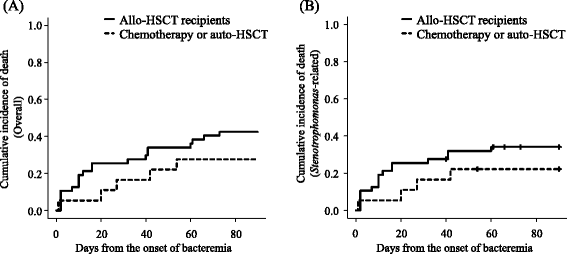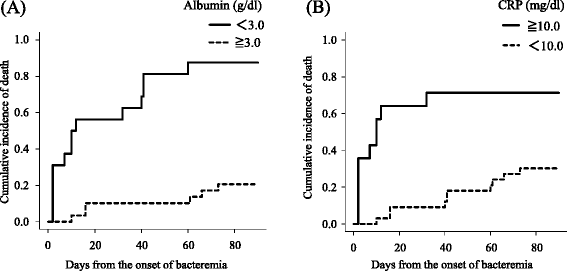Predictive implications of albumin and C-reactive protein for progression to pneumonia and poor prognosis in Stenotrophomonas maltophilia bacteremia following allogeneic hematopoietic stem cell transplantation
- PMID: 28938875
- PMCID: PMC5610439
- DOI: 10.1186/s12879-017-2745-6
Predictive implications of albumin and C-reactive protein for progression to pneumonia and poor prognosis in Stenotrophomonas maltophilia bacteremia following allogeneic hematopoietic stem cell transplantation
Abstract
Background: Stenotrophomonas maltophilia (S. maltophilia) bacteremia causes significant morbidity and mortality in immunocompromised hosts. However, incidence and risk factors for mortality in S. maltophilia bacteremia following allogeneic hematopoietic stem cell transplantation (allo-HSCT) remain controversial. The primary aim of this study is to clarify factors associated with poor prognosis of allo-HSCT recipients with S. maltophilia bacteremia.
Methods: From January 2005 to December 2014, patients with hematological diseases and S. maltophilia bacteremia at a single transplantation center in Japan were examined for incidence and 90-day mortality. Prognostic factors associated with 90-day mortality among allo-HSCT recipients were analyzed by log-rank test, and significant variables in the univariate analysis were included in the multivariate Cox proportional-hazards regression model.
Results: A total of 65 patients, including 47 patients undergoing allo-HSCT, developed S. maltophilia bacteremia. The incidence of S. maltophilia bacteremia was significantly higher in allo-HSCT recipients compared to patients not receiving allo-HSCT (6.53 vs. 0.36 per 100 admissions, respectively; p < 0.01). The overall 90-day mortality in allo-HSCT recipients was 43%. Independent risk factors for 90-day mortality were low serum albumin (<3.0 g/dl) (HR = 10.86; 95% CI, 3.27-36.12) and high serum C-reactive protein (CRP) (≥10.0 mg/dl) (HR = 3.28; 95% CI, 1.00-10.72). Among 9 patients with both high CRP and low albumin, 5 had pneumonia at the onset of bacteremia and the remaining 4 patients developed pneumonia in a median of 3 days (range, 1 to 8 days) even under effective treatment. All 9 patients eventually died in a median of 2 days (range, 2 to 32 days). The probabilities of developing pneumonia in patients with or without high CRP and low albumin levels were 100% (9/9) and 10.5% (4/38), respectively (p < 0.01).
Conclusions: Allo-HSCT recipients had higher rates of S. maltophilia bacteremia than did patients not receiving allo-HSCT. High serum CRP and low serum albumin at the onset of bacteremia are predictive of disease progression to pneumonia and poor prognosis.
Keywords: Albumin; C-reactive protein; Hematopoietic stem cell transplantation; Stenotrophomonas maltophilia.
Conflict of interest statement
Ethics approval and consent to participate
The Ethics Review Committee at the Tokyo Metropolitan Cancer and Infectious Diseases Center Komagome Hospital approved this study. Informed consent is not required for this type of retrospective study.
Consent for publication
Not applicable.
Competing interests
The authors declare that they have no competing interests.
Publisher’s Note
Springer Nature remains neutral with regard to jurisdictional claims in published maps and institutional affiliations.
Figures



References
-
- Chaplow R, Palmer B, Heyderman R, Moppett J, Marks DI. Stenotrophomonas maltophilia bacteraemia in 40 haematology patients: risk factors, therapy and outcome. Bone Marrow Transplant. 2010;45:1109–10. - PubMed
MeSH terms
Substances
Supplementary concepts
LinkOut - more resources
Full Text Sources
Other Literature Sources
Medical
Research Materials
Miscellaneous

